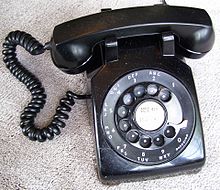- Pulse dialing
-
Pulse dialing, dial pulse, or loop disconnect dialing, also called rotary or decadic dialling in the United Kingdom (because up to 10 pulses are sent), is pulsing in which a direct-current pulse train is produced by interrupting a steady signal according to a fixed or formatted code for each digit and at a standard pulse repetition rate.
Dial pulsing originated with a rotary dial integrated into telephone instruments, for the purpose of signaling. Subsequent applications use electromechanical or electronic circuits to generate dial pulses.
A Rotary dial, seen from the back while generating pulses. The green LED is blinking off as the connection is broken.
The pulses are generated through the making and breaking of the telephone connection (akin to flicking a light switch on and off); the audible clicks are a side effect of this. As a result, all that is really needed to dial a number with pulse dialing is a switch. Each digit in the number is represented by a different number of rapid clicks. In most countries one click is used for the digit 1, two clicks for 2, and so on, with ten clicks for the digit 0; this makes the code unary, excepting the digit 0. Exceptions to this are New Zealand, with ten clicks for 0, nine clicks for 1, and so on; Sweden, with one click for 0, two clicks for 1, and so on; and in Oslo, the capital city of Norway, where the 'New Zealand' system was used in inverse to the rest of the country.
Individual digits in a phone number need to be separated with a short pause so as not to bleed into each other (originally, to give the rotary relays at the exchange time to rotate) and in keypad based pulse dialing digits need to be "buffered" when dialed rapidly. In rotary systems this interdigit interval is provided by the slow rotation of the mechanical dial.
Pulse dialing replaced the two telegraph keys used by telephones connected to the original Strowger exchange to control its vertical and horizontal magnets. With the new system, rather than tap each telegraph key the correct number of times, the user first dialed the vertical number, and then the horizontal number. A slow-release relay detected the interval between the two pulse trains, later standardized to approximately half a second. Director telephone systems and panel switches had equipment to record and decode the digits, which earlier systems had used directly to drive the switches. Dial pulses were further standardized, with a percent break usually specified at approximately 66% and 10 pulses per second. Some telephone systems standardized at 20 PPS. With the spread of Stored Program Control exchanges in the 1970s, pulse counting became a software job.
Most fixed-line phones now use dual tone multi frequency (DTMF, also called touch tone or tone dialing), supported by push-button telephones, rather than pulse dialing, but most telephone equipment retains support for pulse dialing for backward compatibility. Some models of keypad phones have a tone/pulse switch which can be toggled to switch between the two, making these phones usable in areas where DTMF dialing is not accepted.
Tapping
It is possible to trick a phone system into thinking that a rotary dial is being used. To do this, one finds the little button, switch, or hook that is pushed down when the handset is hung up. The switch is then tapped the corresponding number of times at approximately ten taps per second to "dial" the corresponding number (i.e. 1 tap for the digit 1, 2 quick taps for the digit 2, and so on. The pulse dialing rules of Oslo, Norway and New Zealand are an exception; see above). This method can be used when the standard keypad or rotary dial cannot be used although the chances of dialing the wrong number are higher.
In the UK it used to be possible to make calls free of charge from coin-box phones (payphones) by tapping the switch-hook. A person caught tapping could be charged with 'abstracting electricity' from the GPO (several cases of dishonestly using telephones without paying were prosecuted under this offense). As the coin-box dial was designed so that toll (0) and emergency service (999) calls could be made without inserting coins, it was possible to dial the digits "0" and "9" without tapping the switch-hook.
In popular culture, tapping was used in the film Red Dragon as a way for prisoner Hannibal Lecter to dial out and circumvent a phone with no dialing mechanism. This method was also used by the character 'Phantom Phreak' to call 'Acid Burn' when taken to prison in the film Hackers.
Phone locks were sold to prevent unauthorized use of telephones. These attached to the rotary dial and prevented rotation. Tapping was difficult, but not impossible, on standard phones, because the line switch had a slow return characteristic, designed to stop it from accidentally dialing when the handset was not sitting correctly in seat, and to stop it accidentally being triggered when a call was in progress. After the national phone systems were deregulated in many countries, cheaper handsets became available and these cheaper handsets often did not have the slow-return characteristic on the line switch.
See also
- Federal Standard 1037C
- Dual-tone multi-frequency (DTMF) aka 'touch-tone'
- Push-button telephone
Categories:- Telephony signals
Wikimedia Foundation. 2010.

